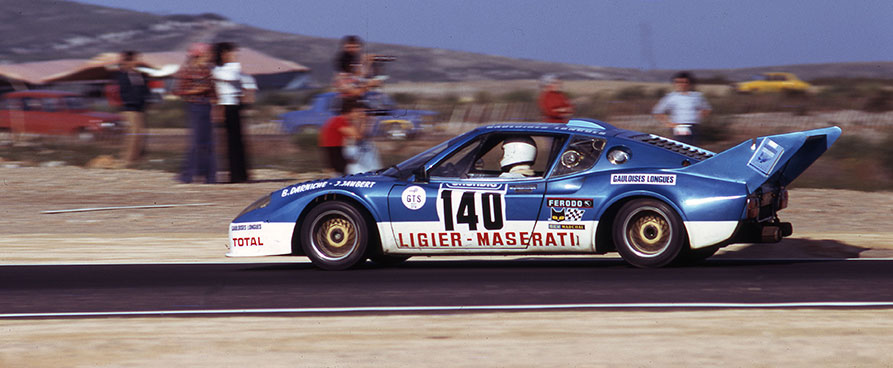
The Ligier JS2s, starred in the 1973 and 1974 Tour de France automobile!
On 30th April 2022 after five days of events, the 2022 Tour Auto on which Ligier left its mark finished in the Principality of Andorra! The #251 Ligier JS2 driven by Mister John of B and Le Commandeur clinched victory in the overall classification in Group H-I. The little French car in its 1975 Le Mans configuration powered by a Cosworth engine scored a win by a short head from Porsche and Ferrari. It was particularly at home in the circuit races. This success recalled the 1973 and 1974 Tour Autos in which the Ligier JS2s clinched their first memorable titles!
In that era, the Tour Auto was still called the Tour de France automobile. This race more than a century old comprised rally and circuit events, an ideal combination for the Ligier JS2, the brand's new GT which reconnected with the constructor's original project, a series production car! After being unveiled at the 1970 Paris Motor Show, the JS2 designed by Michel Têtu and derived from its predecessor, the JS1, made its real debut in 1972 as in the meantime Ford, which was supposed to supply the engine, had let down the French constructor. And now it was with the V6 Maserati engine which powered the Citroën SMs that the JS2 intended to take the fight to its rivals. Unfortunately, the sales of the car didn't take off and as the figure of 500 units was not achieved for the car to race in the right category, the GT group, the JS2 was put in the 3-litre prototype class. Thus, it was unable to fight on a level playing field with the competitors in this category and its first season ended without much success.
Revamps and innovations
But the JS2 had to shine in racing to stimulate the desire of sports car enthusiasts. As Michel Têtu had left, Guy Ligier put his trust in a young engineer just out of university, Michel Beaujon. He immediately got down to tweaking the JS2 to prepare it for the 1973 Tour de France automobile and the 24 Hours of Le Mans, the blue riband events of the era. Beaujon explains:”Major mechanical modifications were made to the car for the 1973 season. We also lightened it a lot and worked on its aerodynamics by giving it a rear wing inspired by an inverted airplane wing profile. It was a first on this type of car! We carried out tests between Boin and Feurs in the Loire department on a long straight road for many kilometers. We arrived around 10pm in the evening and tackled the straight in one direction and then in the other.
“We also did night testing in the mountains in the Bourbonnais region. Guy said that we'd see the headlights of other cars that might be coming against us. It was a very different era!”
1973: the JS2s first headline-making performances
In September, the newly-modified Ligier JS2 tackled the Tour de France automobile. Three JS2s were at the start, but by the end of the second leg only two were still in the running, #114 driven by Gérard Larrousse and Christian Delferrier and #115 in the hands of Guy Chasseuil and Christian Baron.”In the first leg on the Charade circuit,” remembers Beaujon,” an incident heavily penalised #115. The rubber bag tanks located in the wings containing the fuel, as required by the regs, split in two! Guy Chasseuil was swimming in petrol. It could have ended in disaster!” While the two Ligiers won 14 of the 17 special stages in this edition (11 for #115 and 3 for #111), #114 was forced to retire and #115 was never able to make up the time lost. It finished tenth overall. But throughout the whole event the two cars gave their immediate rivals the Lancias and Porsches a great run for their money and they made a big impact.
1974: The Ligiers' revenge!
In 1974, the Tour de France automobile public discovered the JS2 in its new metallic blue livery. It was goodbye to its previous sponsor BP's bright yellow and welcome to the Total colours! The modifications made to the JS2 were not confined to its livery as Beaujon and his team continued to work on the car. The front and the rear wing were remodeled which improved the car's roadholding. The engine too was more powerful. These improvements left their rivals very little chance. The JS2's new crews were out of the top drawer! In #139 Larrousse-Nicolas-Rives and the duo Darniche-Jaubert in #140 made the sparks fly. The Ligiers took their revenge on the Lancias and Porsches by scoring a magnificent double.
Unfortunately, this victory had little effect on the sales. The major reasons were the new speed limits and the consequences of the first petroleum shock, which put off potential sports car buyers. So the JS2 remained stuck in the prototype category.
Despite this handicap, the French GT continued its racing career and powered by a V8 Ford Cosworth, it scored one of its best sporting results a year later. Citroën had just been bought by Peugeot, which stopped the production of the SMs and the V6 Maserati in 1974. In 1975, Ligier went back to the original engine supplier which, this time, agreed to share its engine with the small French team. Although the Tour de France automobile was no longer on the calendar there was still the 24 Hours of Le Mans. The no. 6 JS2 driven by Chasseuil and Lafosse just missed out on victory and finished second. But this podium was its swansong. Not until the end of 2018 did another GT bearing the Ligier name see the light of day, the Ligier JS2 R - powered by Ford!